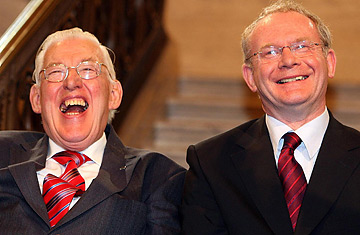
Northern Ireland's First Minister Ian Paisley and Deputy First Minister Martin McGuinness smile after being sworn in as ministers of the Northern Ireland Assembly, at Stormont Parliamentary Building, Belfast, Northern Ireland, Tuesday May 8, 2007.
He wasn't the only spectator with a lot invested in the outcome. Seven seats away and one row back from Blair, three ordinary looking men watched, expressionless, as the new government was formed, only smiling briefly to each other when former IRA bomber Gerry Kelly was nominated to join the new administration. Brian Keenan, Bobby Storey and Brian Gillen were once denounced as IRA terrorists by Peter Robinson, another member of the new government; now they sat in the VIP section of the viewing gallery, well within reach of a British prime minister who would once have been considered the ultimate IRA target.
The IRA, in fact, came close to killing both of Blair's immediate predecessors, bombing a hotel where Margaret Thatcher was staying in 1984 and exploding mortars only yards away from where John Major was holding a cabinet meeting in 1991. That Blair shared the gallery with men once accused of being IRA leaders was a sign of how much has changed in Northern Ireland.
Tuesday's formal opening of the power-sharing government at Stormont, outside Belfast, came after more than 30 years of violence, followed by a decade of false starts and dashed dreams. Even then, this agreement has the air of finality about it, not least because it carries the silent approval of the IRA leadership.
Ten months ago the Reverend Ian Paisley, the thunderous, 81-year-old Protestant preacher who leads the unionists, said the IRA's political allies, Sinn Fein, would enter government "over our dead bodies." Paisley is now the First Minister of Northern Ireland, heading the new administration alongside former IRA leader Martin McGuinness. These days he reckons the region is "starting upon the road — I emphasize starting — which I believe will take us to lasting peace."
His change of heart is both a symptom and a cause of the hope that has settled over Northern Ireland — precisely because the new peace agreement has been brokered among the hardliners of both sides. The peace process had initially been built around moderate parties — David Trimble's Democratic Unionists and the Social Democratic Labor Party of John Hume — but voters from each community gradually opted to be represented at the negotiating table by tougher parties. A majority of Protestant voters thought Paisley's Democratic Unionist Party, which had rejected the earlier process, offered the best to chance to stop Sinn Fein from dominating; many Catholics felt safest being represented by Sinn Fein, the IRA's political allies.
Once the two extremes dominated the mainstream, the only way to an agreement was to get them to strike the deal. Now that they have, the very fact that Paisley and McGuinness have been so tough with each other in the past means that that only marginal elements reject the new deal.
Blair's success in bringing the two sides together, engineered alongside Irish premier Bertie Ahern, has raised suggestions that he could turn his attention to a role in the Middle East after leaving office. Blair would be the first to recognize that the solution for one conflict doesn't simply apply to another, but he could, nonetheless, carry some valuable lessons from the Northern Ireland process.
One lesson would be the subtle use of carrots and sticks: Blair was frequently berated by Unionists — usually Paisley — for granting concessions to the IRA. But he usually did so only in exchange for an irreversible step by the militants: First they gave up their campaign of violence; then they destroyed their weapons. This year, as one of the final pieces of the jigsaw, Irish nationalists gave up their longstanding taboo against cooperating with the Northern Ireland police.
Another lesson is flexibility: When Unionists dumped Nobel Peace Prize winner David Trimble as their leader, Blair adapted the process to bring in Paisley. He also employed "creative ambiguity" to get over the toughest hurdles by letting each side believe they were scoring points. Even today the central question of whether Northern Ireland will ultimately be British or Irish remains unresolved, but the matter will be settled in politics.
Perhaps more than anything, though, Blair brought patience and determination. Even when more pressing issues of global importance put demands on him, he still devoted extraordinary amounts of time to Northern Ireland — even though it offered him almost no political benefits.
Blair's hard work usually bought time, however, and that was crucial. The more people in Northern Ireland became accustomed to a peaceful atmosphere, and the improving economy that came with it, the harder it became to contemplate a return to violence. A decade after he launched the process, Blair — and the IRA leadership — can contemplate retiring in peace.
